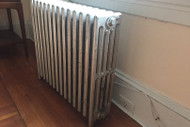Repairing Radiators
Sep 26th 2018
Old radiators can be finicky, but that does not mean you have to live in the cold. We will gladly walk you through the basic repairs for radiators.
First you ahve to know if your home has a hot water or a steam radiator.

In a steam system, steam quickly heats the radiator when the boiler fires. In a hot water system, heated water continually circulates through the radiators. A steam radiator has a small air vent near the top that emits bursts of steam when the radiator heats. Steam systems cycle between hot and cold. Most are connected to only one pipe at the floor, but some have two. You can dismantle and service a steam radiator valve if the boiler is off. It can be difficult to work on, however, because the high heat tends to seize up the pipe joints.
Hot water radiators are connected to two pipes at the floor. They maintain a constant warmth, rather than cycling between hot and cold. Before you dismantle a hot water radiator valve, you must drain the system.
Step 1: Tighten Nutes - If water leaks from beneath the handle, turn down the thermostat and wait for the radiator to cool. Tighten the packing nut (just under the handle) using groove-joint pliers and tighten the larger union nut using a pipe wrench. If this does not solve the problem, move on to the next step.
Step 2: Drain the Radiator - With a hot water system, water must be drained from the radiator. Turn down the thermostat. Attach a hose to the boiler's drain valve and run the hose to a floor drain; open the valve to drain the system. Starting at the top floor of your house, open the bleeder valves of all radiators.
Step 3: Wrap the Stem - Unscrew the packing nut and remove the stem, first by unscrewing and then by pulling it out. If the leak originates just under the handle, wrap the stem with strand packing and reinstall. If the leak is lower or if this does not solve the problem, continue to step 4.
Step 4: Replace Valve - Unscrew the union nut that attaches the valve to the radiator, then unscrew the valve from the pipe. Take the old valve to a plumbing and heating supply store to find an exact replacement; look carefully to be sure it will fit. You also may need to replace the short pipe that emerges from the radiator.
How to Install New Handle
If a handle is cracked or loose, remove the top screw and pull off the old handle. If the stem's threads are in good shape, buy a replacement handle that has the same size screw. If the stem is damaged, buy a "fits-all" handle, which clamps onto the stem with a setscrew.
How to Install the Adjustable Air Vent
A steam radiator valve must be turned either all the way on or all the way off. To adjust the heat, an adjustable air vent is used. Turn down the thermostat and use pliers to unscrew the old air vent. Buy a compatible adjustable unit. Wrap the threads with pipe-thread tape and screw the new unit in place.
How to Adjust the Bleeder Valve
If a hot water radiator is not heating enough, air may be trapped inside. Turn the thermostat up and wait for the radiator to get warm. Hold a cup under the bleeder valve and open it with a bleeder key, long-nose pliers, or screwdriver. Spluttering water or hissing air may come out. Once water flows in a steady stream, tighten the valve.
How to Maximize Air Flow
To improve a radiator's performance, move furniture and other obstructions out of the way. Air should flow freely under and above the radiator. A sheet of aluminum or reflective insulation placed behind the radiator directs more heat into the room.


